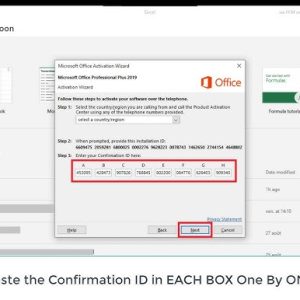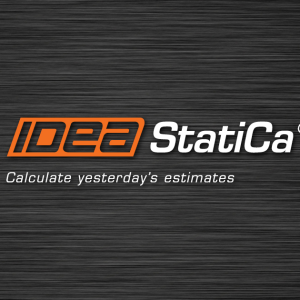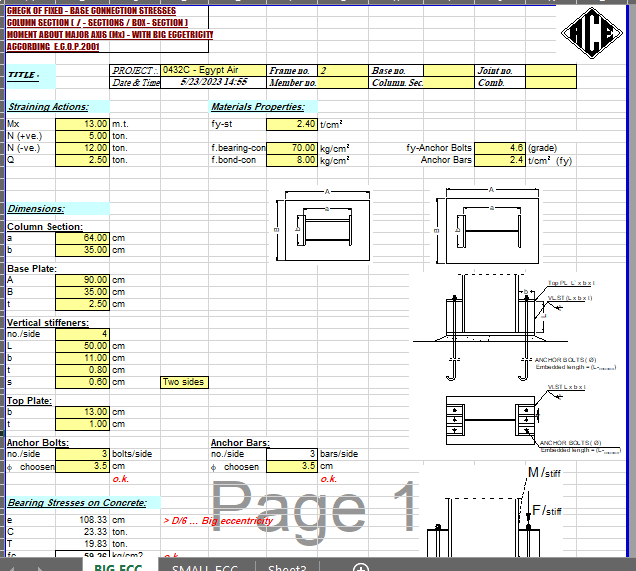-
 MS Office Home & Business 2024 – Lifetime License Key – Mac/PC$150.00 – $160.00
MS Office Home & Business 2024 – Lifetime License Key – Mac/PC$150.00 – $160.00 -
![CHECK OF FIXED - BASE CONNECTION STRESSES COLUMN SECTION ( I - SECTIONS / BOX - SECTION ) MOMENT ABOUT MAJOR AXIS (Mx) - WITH BIG ECCETRICITY ACCORDING E.C.O.P.2001 4 [Retail] Office 2021/2019/2016 Pro Plus Activates 5 PCs Online](https://civilmdc.com/wp-content/uploads/2024/05/Microsoft-Office-professional-plus-all-in-one-free-download-e1717158603220-300x300.jpg) [Retail] Office 2021/2019/2016 Pro Plus Activates 5 PCs Online$50.00 – $120.00
[Retail] Office 2021/2019/2016 Pro Plus Activates 5 PCs Online$50.00 – $120.00 -
 Microsoft office /Windows Activation Service for Phone Activation Method (Get Confirmaiton ID)$3.00
Microsoft office /Windows Activation Service for Phone Activation Method (Get Confirmaiton ID)$3.00 -
 MS SQL Server 2022 Standard | 1 Key for 1 PC$80.00
MS SQL Server 2022 Standard | 1 Key for 1 PC$80.00 -
 Youtube Premium | 4 months Premium Membership$10.00
Youtube Premium | 4 months Premium Membership$10.00 -
Product on sale
 Adobe Stock 40 creditsOriginal price was: $99.00.$20.00Current price is: $20.00.
Adobe Stock 40 creditsOriginal price was: $99.00.$20.00Current price is: $20.00. -
Product on sale
 MS Office 2021 Home & Business 1 MAC Bind for iOSOriginal price was: $429.00.$85.00Current price is: $85.00.
MS Office 2021 Home & Business 1 MAC Bind for iOSOriginal price was: $429.00.$85.00Current price is: $85.00. -
 MS Office 365 Personal | Family Plan on Your Email Id – 1 Year subscription$30.00 – $66.00
MS Office 365 Personal | Family Plan on Your Email Id – 1 Year subscription$30.00 – $66.00 -
 MS Project Professional 2024 | 2021 | 2019 | 2016 1 PC Online key Activation$20.00 – $80.00
MS Project Professional 2024 | 2021 | 2019 | 2016 1 PC Online key Activation$20.00 – $80.00 -
Product on sale
 Adobe Creative Cloud (All apps) – PersonalOriginal price was: $560.00.$200.00Current price is: $200.00.
Adobe Creative Cloud (All apps) – PersonalOriginal price was: $560.00.$200.00Current price is: $200.00. -
 Windows Server 2019 Online Key$22.00
Windows Server 2019 Online Key$22.00 -
 MS Office Visio Professional 2024 | 2021 | 2019 | 2016 PC Online Key Activation$20.00 – $80.00
MS Office Visio Professional 2024 | 2021 | 2019 | 2016 PC Online Key Activation$20.00 – $80.00 -
Product on sale
 MS 2019 Project Professional Windows 1 PC Online keyOriginal price was: $429.00.$22.00Current price is: $22.00.
MS 2019 Project Professional Windows 1 PC Online keyOriginal price was: $429.00.$22.00Current price is: $22.00. -
 McAfee LiveSafe Internet Security Antivirus 1 PC – 10 YEARS – Key$29.00
McAfee LiveSafe Internet Security Antivirus 1 PC – 10 YEARS – Key$29.00 -
 Office Professional 2016 /2013/2010 – Lifetime License Key – 1PC$14.00 – $16.00
Office Professional 2016 /2013/2010 – Lifetime License Key – 1PC$14.00 – $16.00
To check the fixed-base connection stresses in a column section (I-sections/box-section) with a major axis moment (Mx) and a large eccentricity according to E.C.O.P.2001 (Eurocode for the Design of Steel Structures), you would typically follow the design procedure outlined in the code. However, as an AI text-based model, I can provide you with a general overview of the process involved. It’s important to note that the design procedures can vary depending on the specific provisions of the code and the structural configuration.
Here’s a general outline of the steps involved:
- Determine the applied loads: Identify the axial load and the major-axis moment (Mx) acting on the column section. These loads should be based on the structural analysis and design requirements.
- Check for global stability: Ensure that the column section satisfies the overall stability requirements of the code. This involves checking the slenderness ratio and considering any applicable buckling modes.
- Calculate the design resistance of the column section: Determine the cross-sectional properties (e.g., area, moments of inertia) of the column section. Use these properties, along with the material properties (yield strength, modulus of elasticity), to calculate the design resistance of the section against the applied loads. The resistance calculation should consider both axial and bending effects.
- Determine the internal forces and moments: Analyze the fixed-base connection to determine the internal forces and moments transmitted to the column section. This analysis should consider the eccentricity of the applied major-axis moment (Mx). The connection type and its characteristics will influence the distribution of forces and moments.
- Check the stress limits: Compare the design internal forces and moments with the resistance of the column section. Ensure that the stresses induced in the column section due to the combined effect of axial load and bending moment are within the permissible limits specified by E.C.O.P.2001. These limits may include yield stress, ultimate stress, and strain compatibility criteria.
- Modify the design if necessary: If the stresses exceed the permissible limits, the design may need to be modified. Potential modifications could include adjusting the section size, adding reinforcement, or changing the connection configuration.
- Perform detailing: Once the design is satisfactory, proceed with the detailed design of the column section and the fixed-base connection. This involves specifying the reinforcement details, connection details, and any necessary anchorage requirements.
-
 Bitdefender Total Security Antivirus | Genuine Activation Code$30.00
Bitdefender Total Security Antivirus | Genuine Activation Code$30.00 -
 IDEA StatiCa Education$30.00
IDEA StatiCa Education$30.00 -
 Stealth Writer AI | Bypass AI Detection | Get 100% Human Score$10.00
Stealth Writer AI | Bypass AI Detection | Get 100% Human Score$10.00 -
 Adobe Acrobat XI Professional with License Key Activation$29.00
Adobe Acrobat XI Professional with License Key Activation$29.00 -
 Autocad 2007 – OFFLINE INSTALLER + Video Tutorial Install and activation – LIFETIME$7.00
Autocad 2007 – OFFLINE INSTALLER + Video Tutorial Install and activation – LIFETIME$7.00 -
 ChatGPT PLUS Subscription$7.00
ChatGPT PLUS Subscription$7.00 -
 ESET Internet Security Antivirus | 1 Year License$20.00
ESET Internet Security Antivirus | 1 Year License$20.00 -
 Course Hero Account
Course Hero Account1 month
$10.00 -
 General Software Collection | Request books, Codes, Research Articles | Request Software on Demand$3.00 – $35.00
General Software Collection | Request books, Codes, Research Articles | Request Software on Demand$3.00 – $35.00 -
 Vmware Workstation 16 Pro Lifetime License$150.00 – $199.00
Vmware Workstation 16 Pro Lifetime License$150.00 – $199.00 -
 NORD VPN/IP Vanish Account Subscription 6 Month | 1 Year | 2 Years$20.00 – $60.00
NORD VPN/IP Vanish Account Subscription 6 Month | 1 Year | 2 Years$20.00 – $60.00 -
 Internet Download Manager IDM Version 6.41 fully lifetime activation with installation video | 5 times faster download (Pre-Activated)$6.00
Internet Download Manager IDM Version 6.41 fully lifetime activation with installation video | 5 times faster download (Pre-Activated)$6.00 -
 Adobe Acrobat Pro DC 2024 | 2023 | 2022 | 2021 | 2020 | Latest Full Version | Lifetime$10.00 – $20.00
Adobe Acrobat Pro DC 2024 | 2023 | 2022 | 2021 | 2020 | Latest Full Version | Lifetime$10.00 – $20.00 -
![CHECK OF FIXED - BASE CONNECTION STRESSES COLUMN SECTION ( I - SECTIONS / BOX - SECTION ) MOMENT ABOUT MAJOR AXIS (Mx) - WITH BIG ECCETRICITY ACCORDING E.C.O.P.2001 31 Sketch Up Pro 2025 | 2024 | 2023 | 2022 | 2021 Full Package Bundle + Vray 7 + Enscape 4.4 + Thea Render 3.5 [Lifetime & Full]](https://civilmdc.com/wp-content/uploads/2022/03/SketchUp-2025-300x300.jpg) Sketch Up Pro 2025 | 2024 | 2023 | 2022 | 2021 Full Package Bundle + Vray 7 + Enscape 4.4 + Thea Render 3.5 [Lifetime & Full]$10.00 – $45.00
Sketch Up Pro 2025 | 2024 | 2023 | 2022 | 2021 Full Package Bundle + Vray 7 + Enscape 4.4 + Thea Render 3.5 [Lifetime & Full]$10.00 – $45.00 -
 Adobe 2024 | 2023 | 2022 Full Collection$25.00 – $35.00
Adobe 2024 | 2023 | 2022 Full Collection$25.00 – $35.00



 Visit
Visit 